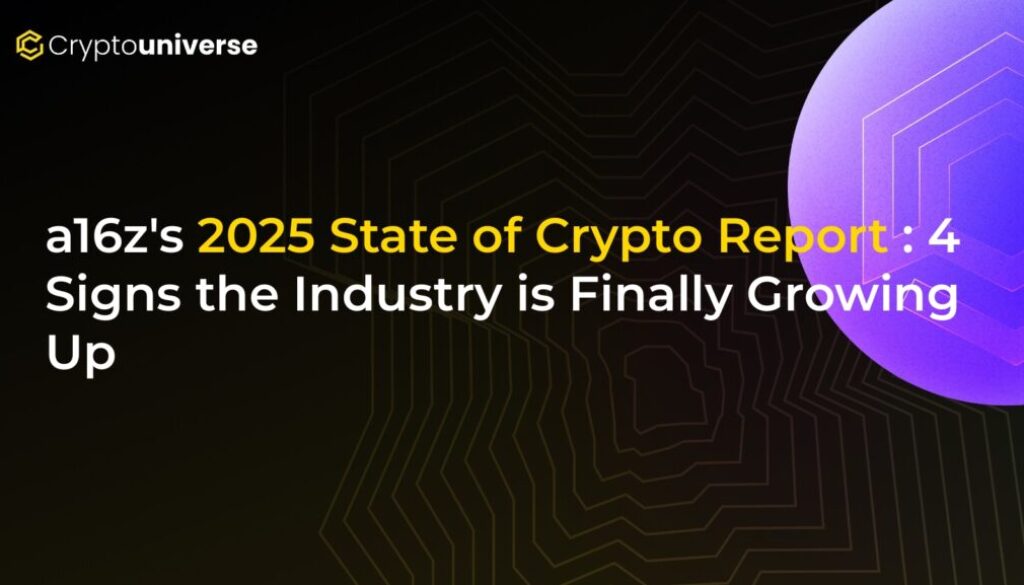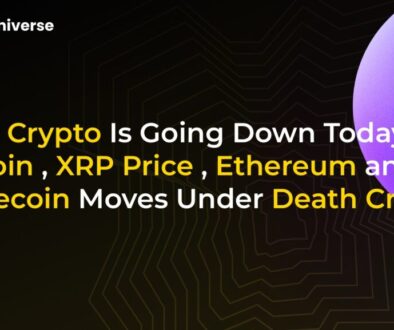a16z’s 2025 State of Crypto Report: 4 Signs the Industry is Finally Growing Up

a16z’s <2025 State of Crypto Report>: 4 Signs the Industry is Finally Growing Up
When venture capital giant Andreessen Horowitz (a16z) speaks, the tech world listens. Their annual State of Crypto report is a landmark event, offering a data-driven snapshot of the industry’s health and trajectory. The 2025 edition has just dropped, and its central theme is loud and clear: crypto is maturing.
Gone are the days when the industry was solely defined by speculative frenzy. According to a16z, crypto has entered a new era driven by tangible utility, institutional buy-in, and long-awaited regulatory clarity. “This year’s story: the maturation of the crypto industry,” the report states, pointing to a confluence of powerful trends.
So, what does this maturation look like on the ground? We’ve dived into the report to bring you the four most important takeaways that signal a pivotal shift for the world of web3.
1. Mainstream Adoption is Here (and It’s Not Just Retail)
For years, the promise of mainstream adoption felt just around the corner. According to a16z, we’ve finally turned that corner. The report highlights a significant jump in the number of monthly active users in web3, now estimated between 40 and 70 million—an increase of 10 million over the past year alone.
While impressive, this figure is still just a fraction of the estimated 716 million people who own crypto globally. This gap signals a massive opportunity: a vast user base of holders is waiting to be converted into active participants as the technology becomes more user-friendly and offers more compelling use cases. The key driver of this shift? The steady and powerful march of institutional investors who are now fully embracing the asset class.
2. The Unstoppable Rise of Stablecoins
Perhaps one of the most powerful indicators of crypto’s maturity is the explosive growth of stablecoins. No longer just a tool for traders to move between volatile assets, stablecoins have become a cornerstone of a new financial infrastructure.
The numbers are staggering. In the last 12 months, stablecoins processed an adjusted transaction volume of $9 trillion. To put that in perspective, payments giant PayPal handled just $1.7 trillion in the same period. This immense volume is fueled by newfound regulatory clarity, particularly the enactment of the landmark GENIUS Act in the United States, which has provided a clear framework for stablecoin issuers.
Even more telling is their role in the broader economy. The report notes that the stablecoin market has become a reliable and significant buyer of U.S. treasuries, stepping in as other countries reduce their holdings. This transforms stablecoins from a crypto-native tool into a key player in the global financial system.
3. Wall Street Has Entered the Chat: TradFi Goes All-In
The line between traditional finance (TradFi) and crypto is blurring faster than ever. The a16z report reveals that dozens of financial behemoths have made significant moves into the crypto space over the last year. This isn’t just about launching a Bitcoin ETF; it’s about active participation and building on-chain.
Prominent names now building in the space include:
- Fidelity
- JPMorgan
- Mastercard
- Visa
This influx of institutional capital and expertise has had a profound effect on the underlying technology. Blockchains have scaled dramatically to meet the demand, now collectively processing 3,400 transactions per second (TPS)—a mind-boggling 100x increase compared to five years ago. Wall Street’s entry isn’t just a vote of confidence; it’s an accelerant for innovation.
4. Beyond the Hype: Crypto Finds Real-World Purpose
For crypto to truly mature, it needs to be more than just a new way to trade. The 2025 report emphasizes the breakout success of new use cases that provide tangible utility beyond speculation.
Three areas, in particular, have gained mainstream traction:
- Perpetual Futures: Once a niche product for sophisticated traders, these crypto-native derivatives have become a standard tool for risk management and speculation across the digital asset landscape.
- Prediction Markets: Decentralized platforms that allow users to bet on the outcome of real-world events are proving to be powerful tools for forecasting and gauging public sentiment.
- Real-World Asset (RWA) Tokenization: This is arguably the most transformative development. The process of converting rights to physical assets—like real estate, art, or private credit—into digital tokens on a blockchain is unlocking trillions of dollars in illiquid value, making these assets more accessible, divisible, and easier to trade.
The Final Takeaway: A New Chapter for Crypto
The message from a16z’s 2025 State of Crypto report is undeniable. The industry has weathered its storms and is now building a resilient, sophisticated, and increasingly integrated foundation for the future of the internet. With institutions onboard, stablecoins serving as a bridge to the traditional economy, and use cases expanding into the real world, crypto is finally delivering on its promise of a more open and efficient financial system. The speculative rollercoaster is making way for a utility-driven superhighway.


